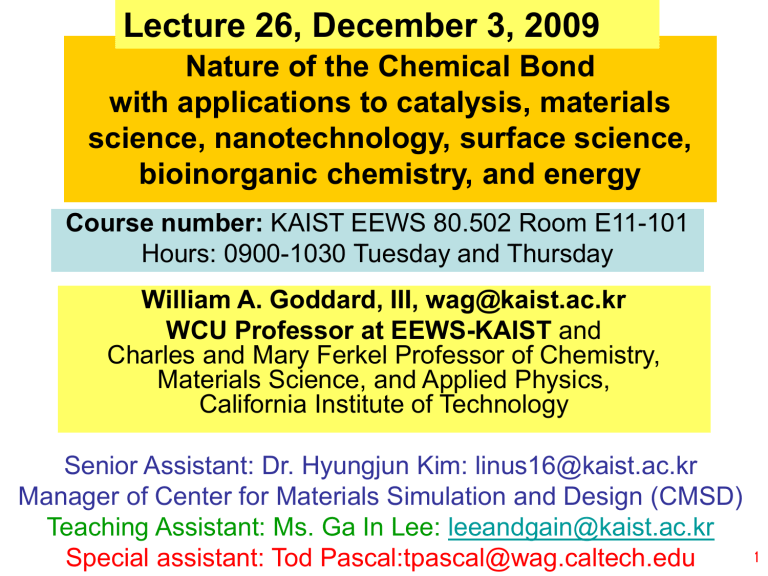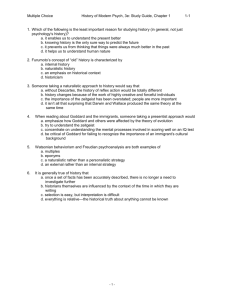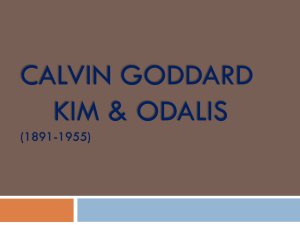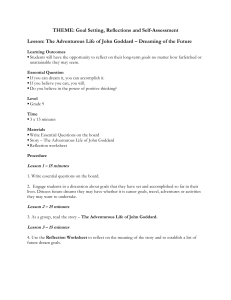
Lecture 26, December 3, 2009
Nature of the Chemical Bond
with applications to catalysis, materials
science, nanotechnology, surface science,
bioinorganic chemistry, and energy
Course number: KAIST EEWS 80.502 Room E11-101
Hours: 0900-1030 Tuesday and Thursday
William A. Goddard, III, wag@kaist.ac.kr
WCU Professor at EEWS-KAIST and
Charles and Mary Ferkel Professor of Chemistry,
Materials Science, and Applied Physics,
California Institute of Technology
Senior Assistant: Dr. Hyungjun Kim: linus16@kaist.ac.kr
Manager of Center for Materials Simulation and Design (CMSD)
Teaching Assistant: Ms. Ga In Lee: leeandgain@kaist.ac.kr
Special assistant:
Tod Pascal:tpascal@wag.caltech.edu
EEWS-90.502-Goddard-L15
© copyright
2009 William A. Goddard III, all rights reserved
1
Schedule changes
Dec. 3, Thursday, 9am, L26, as scheduled
Dec. 7-10 wag in Pasadena; no lectures,
Dec. 14, Monday, 2pm, L27, additional lecture, room 101
Dec. 15, Final exam 9am-noon, room 101
EEWS-90.502-Goddard-L15
© copyright 2009 William A. Goddard III, all rights reserved
2
Last time
EEWS-90.502-Goddard-L15
© copyright 2009 William A. Goddard III, all rights reserved
3
Bonding in metallic solids
Mosty of the systems discussed so far in this course have been
covalent, with the number of bonds related to the number of
valence electrons.
Thus we have discussed the bonding of molecules such as CH4,
benzene, O2, and Ozone.. The solids such as diamond, silicon,
GaAs, are generally insulators or semiconductors
We have also considered covalent bonds to metals such as FeH+,
(PH3)2Pt(CH3)2, (bpym)Pt(Cl)(CH3), The Grubbs Ru catalysts
We have also discussed the bonding in ionic materials such as
(NaCl)n, NaCl crystal, and BaTiO3, where the atoms are best
modeled as ions with the bonding dominated by electrostatics
Next we consider the bonding in bulk metals, such as iron, Pt, Li,
etc. where there is little connection between the number of bonds
and the number of valence electrons.
4
EEWS-90.502-Goddard-L15
© copyright 2009 William A. Goddard III, all rights reserved
Bringing atoms together to form the solid
As we bring atoms together to
form the solid, the levels broaden
into energy bands, which may
overlap . Thus for Cu we obtain
Energy
Fermi energy
(HOMO and
LUMO
Thus we can
obtain
systems with
no band gap.
EEWS-90.502-Goddard-L15
Density states
© copyright 2009 William A. Goddard III, all rights reserved
5
Metals vs inulators
EEWS-90.502-Goddard-L15
© copyright 2009 William A. Goddard III, all rights reserved
6
conductivity
EEWS-90.502-Goddard-L15
© copyright 2009 William A. Goddard III, all rights reserved
7
The elements leading to metallic binding
There is not yet a conceptual description for metals of a
quality comparable to that for non-metals. However
there are some trends, as will be described
EEWS-90.502-Goddard-L15
© copyright 2009 William A. Goddard III, all rights reserved
8
Body centered cubic (bcc), A2
A2
EEWS-90.502-Goddard-L15
© copyright 2009 William A. Goddard III, all rights reserved
9
Face-centered cubic (fcc), A1
EEWS-90.502-Goddard-L15
© copyright 2009 William A. Goddard III, all rights reserved
10
Alternative view of fcc
EEWS-90.502-Goddard-L15
© copyright 2009 William A. Goddard III, all rights reserved
11
Closest packing layer
EEWS-90.502-Goddard-L15
© copyright 2009 William A. Goddard III, all rights reserved
12
Stacking of 2 closest packed layers
EEWS-90.502-Goddard-L15
© copyright 2009 William A. Goddard III, all rights reserved
13
Hexagaonal
closest packed
(hcp) structure, A3
EEWS-90.502-Goddard-L15
© copyright 2009 William A. Goddard III, all rights reserved
14
Cubic closest packing
EEWS-90.502-Goddard-L15
© copyright 2009 William A. Goddard III, all rights reserved
15
Double hcp
The hexagonal lanthanides mostly exhibit a
packing of closest packed layers in the
sequence
ABAC ABAC ABAC
This is called the double hcp structure
EEWS-90.502-Goddard-L15
© copyright 2009 William A. Goddard III, all rights reserved
16
mis
fcc
hcp
b cc
Structures of elemental metals
some correlation of
structure with number of
valence electrons
EEWS-90.502-Goddard-L15
© copyright 2009 William A. Goddard III, all rights reserved
17
Binding in metals
Li has the bcc structure with 8 nearest neighbor atoms, but there
is only one valence electron per atom.
Similarly fcc and hcp have 12 nearest neighbor atoms, but Al has
only three valence electrons per atom.
Clearly the bonding is very different than covalent
One model (Pauling) resonating valence bonds
Problem is energetics:
Li2 bond energy = 24 kcal/mol 12
kcal/mol per valence electron
Cohesive energy of Li (energy to atomize the crystal is 37.7
kcal/mol per valence electron. Too much to explain with resonance
New paradigm: Interstitial electron model (IEM). Each valence
electron localizes in a tetrahedron between four Li nuclei.
+, which is 33.7 kcal/mol per valence electron
Bonding
like
in
Li
2
EEWS-90.502-Goddard-L15
© copyright 2009 William A. Goddard III, all rights reserved
18
GVB orbitals of ring M10 molecules
Get 10 valence electrons
each localized in a bond
midpoint
R=2 a0
EEWS-90.502-Goddard-L15
Calculations treated all 11
valence electrons of Cu,
Ag, Au using effective core
potential.
All electrons for H and Li
© copyright 2009 William A. Goddard III, all rights reserved
19
EEWS-90.502-Goddard-L15
© copyright 2009 William A. Goddard III, all rights reserved
20
EEWS-90.502-Goddard-L15
© copyright 2009 William A. Goddard III, all rights reserved
21
EEWS-90.502-Goddard-L15
© copyright 2009 William A. Goddard III, all rights reserved
22
EEWS-90.502-Goddard-L15
© copyright 2009 William A. Goddard III, all rights reserved
23
EEWS-90.502-Goddard-L15
© copyright 2009 William A. Goddard III, all rights reserved
24
EEWS-90.502-Goddard-L15
© copyright 2009 William A. Goddard III, all rights reserved
25
EEWS-90.502-Goddard-L15
© copyright 2009 William A. Goddard III, all rights reserved
26
New
EEWS-90.502-Goddard-L15
© copyright 2009 William A. Goddard III, all rights reserved
27
Hypervalent compounds
It was quite a surprize to most chemists in 1962 when Neil
bartlett reported the formation of a compound involving XeF bonds. But this was quickly folllowed by the synthesis of
XeF4 (from Xe and F2 at high temperature and XeF2 in
1962 and later XeF6.
Indeed Pauling had predicted in 1933 that XeF6 would be
stable, but noone tried to make it.
Later compounds such as ClF3 and ClF5 were synthesized
These compounds violate simple octet rules and are call
hypervalent
EEWS-90.502-Goddard-L15
© copyright 2009 William A. Goddard III, all rights reserved
28
Noble gas dimers
Recall from L17 that there is no
chemical bonding in He2, Ne2 etc
This is explained in VB theory as due
to repulsive Pauli repulsion from the
overlap of doubly occupied orbitals
It is explained in MO theory as due
to filled bonding and antibonding
orbitals
EEWS-90.502-Goddard-L15
(sg)2(su)2
© copyright 2009 William A. Goddard III, all rights reserved
29
Noble gas dimer positive ions
On the other hand the positive ions
are strongly bound (L17)
This is explained in MO theory
as due to one less antibonding
electron than bonding, leading to
a three electron bond for He2+ of
2.5 eV, the same strength as the
one electron bond of H2+
(sg)2(su)1
The VB explanation is a little
Using (sg) = L+R and (su)=L-R
less straightforward. Here
we consider that there are
Leads to (with negative sign
two equivalent VB
structures neither of which
leads to much bonding, but
superimposing them leads
EEWS-90.502-Goddard-L15
© copyright 2009 William A. Goddard III, all rights reserved
to
resonance stabilization
30
Re-examine the bonding of HeH
Why not describe HeH as (sg)2(su)1 where
(sg) = L+R and (su)=L-R
Would this lead to bonding?
The answer is no, as easily seen with the VB form where the
right structure is 23.9 eV above the left. Thus the energy for the
(sg)2(su)1 state would be +12.0 – 2.5 = 9.5 eV unbound at R=∞
Adding in ionic stabilization lowers the energy by 14.4/2.0 = 7.2
eV (too big because of shielding) , still unbound by 2.3 eV
He
EEWS-90.502-Goddard-L15
H
H-
He+
IP=+24.6 eV
EA = 0.7 eV 31
© copyright 2009 William A. Goddard III, all rights reserved
Examine the bonding of XeF
Consider the energy to form the charge transfer complex
Xe
Xe+
The energy to form Xe+ F- can be estimated from
Using IP(Xe)=12.13eV, EA(F)=3.40eV, and
R(IF)=1.98 A, we get
E(Xe+ F-)=1.45eV
Thus there is no covalent bond for XeF, which has
a weak bond of ~ 0.1 eV and a long bond
EEWS-90.502-Goddard-L15
© copyright 2009 William A. Goddard III, all rights reserved
32
Examine the bonding in XeF2
We saw that the energy to form Xe+F-,
now consider, the impact of putting a
2nd F on the back side of the Xe+
Xe+
Since Xe+ has a singly occupied pz orbital pointing directly at this
2nd F, we can now form a bond to it?
How strong would the bond be?
Probably the same as for IF, which is 2.88 eV.
Thus we expect F--Xe+F- to have a bond strength of ~2.88 – 1.45
= 1.43 eV!
Of course for FXeF we can also form an equivalent bond for
F-Xe+--F. Thus we get a resonance
We will denote this 3 center – 4 electron charge transfer bond as
FXeF
EEWS-90.502-Goddard-L15
© copyright 2009 William A. Goddard III, all rights reserved
33
Stability of XeF2
Ignoring resonance we predict that XeF2 is stable by 1.43 eV. In
fact the experimental bond energy is 2.69 eV suggesting that the
resonance energy is ~ 1.3 eV.
The XeF2 molecule is stable by 2.7 eV with respect to Xe + F2
But to assess where someone could make and store XeF2, say in
a bottle, we have to consider other modes of decomposition.
The most likely might be that light or surfaces might generate F
atoms, which could then decompose XeF2 by the chain reaction
XeF2 + F {XeF + F2} Xe + F2 + F
Since the bond energy of F2 is 1.6 eV, this reaction is
endothermic by 2.7-1.6 = 1.1 eV, suggesting the XeF2 is
relatively stable. Indeed it is used with F2 to synthesize XeF4 and
XeF6.
EEWS-90.502-Goddard-L15
© copyright 2009 William A. Goddard III, all rights reserved
34
XeF4
Putting 2 additional F to overlap
the Xe py pair leads to the
square planar structure, which
allows 3 center – 4 electron
charge transfer bonds in both
the x and y directions, leading to
a square planar structure
The VB analysis would indicate that the stability for XeF4
relative to XeF2 should be ~ 2.7 eV, but maybe a bit weaker
due to the increased IP of the Xe due to the first hypervalent
bond and because of some possible F---F steric interactions.
There is a report that the bond energy is 6 eV, which seems
too high, compared to our estimate of 5.4 eV.
EEWS-90.502-Goddard-L15
© copyright 2009 William A. Goddard III, all rights reserved
35
XeF6
Since XeF4 still has a pz pair, we can form
a third hypervalent bond in this direction to
obtain an octahedral XeF6 molecule.
Here we expect a stability a little less than 8.1 eV.
Pauling in 1933 suggested that XeF6 would be stabile, 30
years in advance of the experiments.
He also suggested that XeF8 is stable. However this
prediction is wrong
EEWS-90.502-Goddard-L15
© copyright 2009 William A. Goddard III, all rights reserved
36
Estimated stability of other Nobel gas fluorides (eV)
Using the same
method as for
XeF2, we can
estimate the
binding energies
for the other
Noble metals.
Here we see that
KrF2 is predicted
to be stable by
0.7 eV, which
makes it
susceptible to
decomposition
by F radicals
EEWS-90.502-Goddard-L15
1.3
1.3
1.3
1.3
1.3
1.3
-2.9
-5.3
-0.1
1.0
2.7
3.9
RnF2 is quite stable, by 3.6
eV, but I do not know if it
37
has been
observed
© copyright 2009 William A. Goddard
III, all rights
reserved
XeCl2
Since EA(Cl)=3.615 eV and R(XeCl+)=2.32A and
De(XeCl+)=2.15eV, can estimate that XeCl2 is stable by
1.14 eV with respect to Xe + Cl2.
However since the bond energy of Cl2 is 2.48 eV, the
energetics of the chain dempostion process are
exothermic by 1.34 eV, suggesting at most a small
barrier
Thus XeCl2 would be difficult to observe
EEWS-90.502-Goddard-L15
© copyright 2009 William A. Goddard III, all rights reserved
38
Halogen Fluorides, ClFn
The IP of ClF is 12.66 eV which
compares well to the IP of
12.13 for Xe.
This suggests that the px and
py pairs of Cl could be used to
form hypervalent bonds leading
to ClF3 and ClF5.
Indeed these estimates suggest
that ClF3 and ClF5 are stable.
Indeed the experiment energy
for ClF3 ClF +F2 is 2.6 eV,
quite similar to XeF2.
EEWS-90.502-Goddard-L15
© copyright 2009 William A. Goddard III, all rights reserved
39
EEWS-90.502-Goddard-L15
© copyright 2009 William A. Goddard III, all rights reserved
40
EEWS-90.502-Goddard-L15
© copyright 2009 William A. Goddard III, all rights reserved
41
EEWS-90.502-Goddard-L15
© copyright 2009 William A. Goddard III, all rights reserved
42
EEWS-90.502-Goddard-L15
© copyright 2009 William A. Goddard III, all rights reserved
43
EEWS-90.502-Goddard-L15
© copyright 2009 William A. Goddard III, all rights reserved
44
EEWS-90.502-Goddard-L15
© copyright 2009 William A. Goddard III, all rights reserved
45
EEWS-90.502-Goddard-L15
© copyright 2009 William A. Goddard III, all rights reserved
46
EEWS-90.502-Goddard-L15
© copyright 2009 William A. Goddard III, all rights reserved
47
EEWS-90.502-Goddard-L15
© copyright 2009 William A. Goddard III, all rights reserved
48
Origin of reactivity in the hypervalent
reagent o-iodoxybenzoic acid (IBX)
Julius Su and William A. Goddard III
Materials and Process Simulation Center,
California Institute of Technology
EEWS-90.502-Goddard-L15
© copyright 2009 William A. Goddard III, all rights reserved
49
Hypervalent iodine assumes many metallic personalities
O
Oxidations
O
O
OH
I
CrO3/H2SO4
OAc
Radical
cyclizations
SnBu3Cl
I
OAc
OH
Electrophilic
alkene activation
CC bond
formation
HgCl2
I
OTs
O
I
Pd(OAc)2
Can we understand iodine as we understand metals?
Martin, J. C. organo-nonmetallic chemistry – Science 1983 221(4610):509-514
EEWS-90.502-Goddard-L15
© copyright 2009 William A. Goddard III, all rights reserved
50
Practical benefits of hypervalent iodine reagents
$/mol
I
2
Pd 1,300
Os 2,300
Ir
2,700
Pt
2,400
Rh 19,500
oral rat LD50 (mg/kg)
I2
14,000
OsO4
162
SeO2
68
Variants possible:
water soluble
polymer supported
non-explosive mixture
Cheap, non-toxic, and environmentally friendly.
EEWS-90.502-Goddard-L15
© copyright 2009 William A. Goddard III, all rights reserved
51
IBX, a single
reagent with
many roles
S
OH
S
OH
O
O
O
I
O
25oC
S
78%
O
1 eq IBX
O
23oC
t-Bu
OH
S
1.1 eq IBX
99%
conv
t-Bu
O
O
2 eq IBX
75oC
CHXH oxidations
phenols to quinones
a,b unsaturation
allylic oxidation
radical cyclization
3 eq IBX
85%
CHO
NH
2 eq IBX
90oC
O
What is the origin of
its diverse reactivity?
EEWS-90.502-Goddard-L15
85%
85oC
N
O
86%
Solvents are DMSO mixtures or CHCl3.
Taken from Palmisano, Nicolaou, McFadden.
© copyright 2009 William A. Goddard III, all rights reserved
52
Theoretical methods
Density functional theory
Harmonic frequencies
Single point continuum solvent
Added d and f functions on I
Needed for correct bond length and
energy, even for covalent iodine bonds
b
mpw
pw
EEWS-90.502-Goddard-L15
Alternative functional
MPW1PW91 for better description
of long range binding
© copyright 2009 William A. Goddard III, all rights reserved
53
Validation against experiment and more accurate theory
70
Includes atom spin-orbit effects,
zero point energy, and BSSE
reference
Energy per bond (kcal/mol)
60
50
40
30
our method
20
10
0
IF
ICl
IBr
I2
IOH
ICH3 XeF+ XeF2 XeF4 XeF6 XeO XeO3 XeO4
-10
-20
Systematic underestimation of bond energies,
but relative energies are accurate.
EEWS-90.502-Goddard-L15
© copyright 2009 William A. Goddard III, all rights reserved
54
Nature of the hypervalent bond
EEWS-90.502-Goddard-L15
© copyright 2009 William A. Goddard III, all rights reserved
55
Multicenter bonds go beyond the covalent bond
H
H
H
Covalent 2c-2e
Strength depends on length only
H
H
H
H
H
H
H
Multicenter 6c-6e
Depends on out-of-plane bend too
energy
H
H
60o bend,
114 kcal/mol
Bond angles and torsions
change multicenter bonds.
Dijkstra, F. et al. bent benzene –
Int J. Quan. Chem 1999 74:213-221
bend (degrees)
EEWS-90.502-Goddard-L15
© copyright 2009 William A. Goddard III, all rights reserved
56
Electron rich or poor multicenter bonds: allyl variations
MO stabilizations are similar
but twisting localizes charge
antibonding
H
H
H
nonbonding
H
H
H
H
H
H
H
H
Etwist
H
H
38
(kcal/mol)
EEWS-90.502-Goddard-L15
H
H
H
H
13
H
H
H
H
H
localized charge,
less stable
bonding
H
H
H
33
Electrostatics makes charged
bonds especially stiff.
Gobbi et al. allyl resonance –
J. Am. Chem. Soc. 1994 116:9275-9286
© copyright 2009 William A. Goddard III, all rights reserved
57
Hypervalent bonds as 3c-4e s bonds
F
+ F2
F
Xe
F
F
Xe
F
F
hn
F
Xe
Xe
F
F
F
F
F
Each lone pair can bond
two fluorines (3c-4e bond)
valence bond picture
molecular orbital picture
Resonance stabilized 180o pairs
EEWS-90.502-Goddard-L15
© copyright 2009 William A. Goddard III, all rights reserved
58
Valence bond explanation of hypervalent bond strengths
E = 2 • (½ covalent + ½ ionic) + resonance
covalent
= D(XeF+)
=
38 kcal/mol
ionic
= IP(Xe) – EA(F) – 1/R =
+35 kcal/mol
resonance
= E(180o) – E(90o)
71 kcal/mol
total
= –74 kcal/mol vs. –62 kcal/mol (expt)
=
Majority of energy comes from resonance stabilization
EEWS-90.502-Goddard-L15
© copyright 2009 William A. Goddard III, all rights reserved
59
Combining different ligand types
I
covalent
O
F
Xe
Xe
dative
crystal structures
F
EEWS-90.502-Goddard-L15
hypervalent
Occupy octahedral
positions
© copyright 2009 William A. Goddard III, all rights reserved
60
Higher order multicenter bonds as transition states
‡
F
I
F
F
F
I
F
F
3c4e
4c6e
DE = 15.5
kcal/mol
High symmetry structure has 2nd order Jahn-Teller distortion
e*
a
LUMO
e
Lower symmetry structure becomes more stable.
EEWS-90.502-Goddard-L15
© copyright 2009 William A. Goddard III, all rights reserved
61
Valence bond comparison of IF3 geometries
In both cases, E = 2 • covalent + ionic + resonance
To a first approximation, both geometries have the same energy.
EEWS-90.502-Goddard-L15
© copyright 2009 William A. Goddard III, all rights reserved
62
VB explanation of C2v vs. D3h energy difference
angle bending
90o
120o
electrostatic repulsion
between ligands
DE(bend) DE(elec)
ClF3
BrF3
IF3
4.0
5.0
6.4
EEWS-90.502-Goddard-L15
12.3
12.0
11.4
sum
DFT
energies in kcal/mol
16.3
17.0
17.7
16.7
17.2
15.4
Accounts for all
observed energy
difference
© copyright 2009 William A. Goddard III, all rights reserved
63
Rules of hypervalent reactivity
EEWS-90.502-Goddard-L15
© copyright 2009 William A. Goddard III, all rights reserved
64
Folk notion of hypervalent bonds as weak and reactive
F
breaking
in oxidation
Xe
F
Eatom = 62 kcal/mol, or
31 kcal/mol per bond
creating an
ionic fragment
single electron
acceptor
Proposed mechanisms focus on reactivity of hypervalent bonds
EEWS-90.502-Goddard-L15
© copyright 2009 William A. Goddard III, all rights reserved
65
Rule 1. Individual hypervalent bonds are strong
F
Xe
F
F
+51 kcal/mol
3e- 2 center s bond,
resonance lost.
EEWS-90.502-Goddard-L15
Xe + F
F + Xe + F
+8 kcal/mol
The first bond is strong,
since breaking it creates
unstable fragments.
© copyright 2009 William A. Goddard III, all rights reserved
66
Rule 2: Bonds next to hypervalent bonds are weakened
3e-, 2 center
p bond is
particularly
stable
44 kcal/mol
41
Adjacent bond weakened by
hypervalent hyperconjugation
13
Hypervalent oxo bond is
particularly effective at
weakening neighboring bond
EEWS-90.502-Goddard-L15
© copyright 2009 William A. Goddard III, all rights reserved
67
Rule 3. Twist switches hypervalent and covalent ligands
hypervalent
bonds circled
3c-4e
4c-6e: promotion to
higher order hypervalent
bond.
3c-4e
Twist proceeds via
D3h transition state,
DE‡ = 15.5 kcal/mol
EEWS-90.502-Goddard-L15
© copyright 2009 William A. Goddard III, all rights reserved
68
IBX oxidation of alcohols
EEWS-90.502-Goddard-L15
© copyright 2009 William A. Goddard III, all rights reserved
69
NMR kinetics study of alcohol oxidation
O
O
OH
O
O
I
fast
O
O
H
R
HO
R'
H
O
R
R'
OH
slow
O
I
I
O
H2O
R
O
R'
axial geometry
Fast ligand exchange
followed by slow oxidation
Large alcohols oxidize faster
than small alcohols
De Munari et al, kinetics study – J. Org. Chem. 1996 61(26):9272-9276
EEWS-90.502-Goddard-L15
© copyright 2009 William A. Goddard III, all rights reserved
70
DFT supports ligand exchange preequilibrium
O
O
O
O
O
OH2
I
O
O
I
OH2
+
HOCH3
HOCH3
protonated IBX
internal ligand rotation
DE‡ = 7.2 kcal/mol
O
O
I
H
OCH3
OH2
swapped ligand
Calculated dG (kcal/mol)
5.00
Low barrier pathway found,
and good correlation between
DG (theory) and Keq (expt)
4.00
3.00
2.00
1.00
0.00
0
0.02
0.04
0.06
methanol, isopropanol, t-BuOH
benzyl alcohol, etc.
Experimental Keq
EEWS-90.502-Goddard-L15
© copyright 2009 William A. Goddard III, all rights reserved
71
Theoretical prediction of alcohol NMR shifts
calc. NMR shielding
1
1
axial geometry
0.8
0.8
0.6
0.6
0.4
0.4
0.2
0.2
0
0
0
0.5
equatorial geometry
0
1
-0.2
-0.2
-0.4
-0.4
-0.6
-0.6
-0.8
-0.8
-1
-1
0.2
0.4
0.6
0.8
1
measured chemical shift (ppm)
Confirms that axial species predominates in solution
EEWS-90.502-Goddard-L15
© copyright 2009 William A. Goddard III, all rights reserved
72
An oxidation mechanism with a twist
H
H
O
+CH3OH
OH
O
O
I
-H2O
H
O
O
O
O
axial
I
hypervalent twist
OH
O
O
O
I
O
O
H
H
O
I
H
O
H
H
equatorial
Complex must twist for oxidation to happen
EEWS-90.502-Goddard-L15
© copyright 2009 William A. Goddard III, all rights reserved
73
Twisting switches strong and weak bonds
We find activating
reactivity by twisting
to be a common theme
EEWS-90.502-Goddard-L15
© copyright 2009 William A. Goddard III, all rights reserved
74
Twisting
9.9 kcal/mol
Oxidation
Ligand exchange
2.6 kcal/mol
7.2 kcal/mol (with H+)
O
O
H
O
O
O
I
+CH3OH
-H2O
O
H
O
H
H
O
OH
H
I
H
O
O
O
I
OH
Hypervalent twisting is rate-limiting
O
O
I
O
H
H
EEWS-90.502-Goddard-L15
© copyright 2009 William A. Goddard III, all rights reserved
75
Size selectivity explained, and an improved reagent?
repulsion
relieved
Large alcohols oxidize faster
because they twist more easily.
OR'
O
EEWS-90.502-Goddard-L15
O
I
OR
An ortho group should
accelerate twisting further.
© copyright 2009 William A. Goddard III, all rights reserved
76
Screening for an optimal ortho substituent
4.5
better twisting
R'
4.0
B(OH)2
Ph
better
alcohol/water
exchange
O
HO
I
3.5
O
3.0
2.5
O
2.0
tBu
best
1.5
B(Ome)2
1.0
Me
Et
0.5
Cl
0.0
H
-7.0
-6.0
F
-5.0
-4.0
-3.0 iPA
-2.0
-1.0
0.0
Large enough to favor
twisted structure
But not so large it hinders
alcohol/water exchange
-0.5
Medium-sized aliphatics (Me, Et, i-Pr) best
EEWS-90.502-Goddard-L15
© copyright 2009 William A. Goddard III, all rights reserved
77
Predicted rate acceleration for ortho-methyl IBX
6
predicted log(kalc /kMeOH )
rate-limiting
ligand
exchange
twisting
H3C HO
O
I
5
O
4
3
100x
faster
rate!
2
1
ipa
0
-1
O
ph
iso
2,4
neo
0 et
1
-1
measured log(kalc/kMeOH)
EEWS-90.502-Goddard-L15
HO O
O
I
O
2
Up to 100x faster,
then limited by
ligand exchange rate
© copyright 2009 William A. Goddard III, all rights reserved
78
Other predictions
n
Etwist‡
Eelim‡
2
-
21.9
3
-
12.8
4
5.9
4.8
5
5.5
3.8
group
Gtwist‡
none
12.1
o-CH3
9.7
o-F
12.1
m-CH3
13.8
m-F
13.9
EEWS-90.502-Goddard-L15
O
n
O
O
O
I
Minimum chain length
needed for oxidation
Meta substituents inhibit
twisting, for unknown reasons
© copyright 2009 William A. Goddard III, all rights reserved
79
Other reactions of IBX
EEWS-90.502-Goddard-L15
© copyright 2009 William A. Goddard III, all rights reserved
80
More complex reactions of IBX
OH
O
O
O
IBX
NH
O
N
O
O
HIO3•DMSO
H
Can we explain mechanism and reagent scope?
Nicolaou, K. C. et al, allylic oxidation – J. Am. Chem. Soc. 2001 123:2183-3185
Nicolaou, K. C. et al, HIO3 reactivity – Angew. Chem. Int. Ed. 2002 41:1386-1388
EEWS-90.502-Goddard-L15
© copyright 2009 William A. Goddard III, all rights reserved
81
Evidence for a single-electron-transfer mechanism
Radical clock moiety fragments:
Ph
Ph
H
Ph
H
Ph
O
O
IBX
Ph
O
Ph
H
Hammett plot mildly e deficient resonance-stabilized TS:
IBX-mediated
cyclization,
r = –1.4
But EA(IBX-OMe) = 14 kcal/mol,
while IP(substrate) = 187 kcal/mol
Experiments suggest yes,
but theory says no.
Nicolaou, K. C. et al, SET model –
J. Am. Chem. Soc. 2002 124(10):2245-2258
EEWS-90.502-Goddard-L15
© copyright 2009 William A. Goddard III, all rights reserved
82
Proposed mechanism
for phenol oxidation
O
OH
MeO
O
IBX
MeO
OMe
O
O
I
O
B
[2,3]
O
first
oxidation
O
I
O
O
O
O
OH
I
O
O
second
oxidation
OMe
O
I
O
B
H
OMe
O
HO
OMe
variant trapped
as Diels-Alder
adduct
breaking both
hypervalent
bonds at once
is okay
Diels-Alder adduct strongly suggests [2,3] involved.
Magdziak, D. et al, phenol oxidation – Org. Lett. 2002 4(2):285-288
EEWS-90.502-Goddard-L15
© copyright 2009 William A. Goddard III, all rights reserved
83
With theory, IBX adducts readily undergo [2,3]
Twisting and [2,3]
rearrangement occurs
in one step.
[2,3]
twist
Transition states:
DE‡ = 3.0 kcal/mol
EEWS-90.502-Goddard-L15
DE‡ = 5.5 kcal/mol
© copyright 2009 William A. Goddard III, all rights reserved
84
Theoretical Hammett analysis of [2,3]/twist step
2.5
r
log (k/k0)
OMe
2
Et
HO
1.5
R
1
0.5
F
-1
sp+
0
-0.5
0
-0.5
0.5
1
Cl
NO2
-1
experiment, THF
-1.4
theory, gas phase
-1.7
theory, THF
-2.1
typical SN2
-2.8
typical cation
-4.5
-1.5
R
[2,3]/twist
Small negative r
mildly electron deficient
resonance stabilized
R
SET
O
O
O
O
O
I
O
O
O
I
Small negative r equally well supports [2,3]/twist
EEWS-90.502-Goddard-L15
© copyright 2009 William A. Goddard III, all rights reserved
85
Proposed mechanisms for IBX reactions
Alcohol oxidation
a,b oxidation
Radical cyclization
EEWS-90.502-Goddard-L15
© copyright 2009 William A. Goddard III, all rights reserved
86
Can now explain most known IBX reactions
Key step is either twist + a elimination or twist/[2,3]
EEWS-90.502-Goddard-L15
© copyright 2009 William A. Goddard III, all rights reserved
87
Reagent scope of IBX versus HIO3•DMSO explained
no twist possible,
only free rotation
can twist
can perform
alcohol oxidation
allylic oxidation
dehydrogenation
radical cyclization
needs
twist
dehydrogenation
radical cyclization
(predicted)
doesn’t
need twist
HIO3 cannot twist, so is limited to [2,3]/twist reactions
EEWS-90.502-Goddard-L15
© copyright 2009 William A. Goddard III, all rights reserved
88
Allylic oxidation
Me 3 eq IBX
CHO
85% yield,
similar results with
25 substrates.
12 h/85oC
DMSO
IBX may generate hydroxy radical in situ:
O
O
O
O
I
O
OH
O
I
stable, like nitroso
+
OH
performs
allylic oxidations?
Otherwise, we still cannot explain this reaction
Nicolaou, K. C. et al, allylic oxidation – J. Am. Chem. Soc. 2001 123:2183-3185
EEWS-90.502-Goddard-L15
© copyright 2009 William A. Goddard III, all rights reserved
89
A new IBX reaction?
EEWS-90.502-Goddard-L15
© copyright 2009 William A. Goddard III, all rights reserved
90
IBX as a generator of alkoxy radicals
When no a hydrogens or
double bonds are available,
we predict thermal homolysis
can occur to generate radicals.
BDE (kcal/mol)
IBX-OMe (untwisted)
IBX-OMe (twisted)
HO-OH
AcO-OAc
HO-ONO
EEWS-90.502-Goddard-L15
60
33
49
38
22
Homolysis only favored in
the twisted form of IBX.
© copyright 2009 William A. Goddard III, all rights reserved
91
Propose experiments to detect or trap alkoxy radical
(most direct)
Spin trapping with PhNO, EPR detection
O
O
O
I
OtBu
Catch radical in fastest
manner possible:
O
O
O
I
O
O
O
Cyclization with substrate
free from other side rxns:
HO
O
Looking for way to exploit or clearly demonstrate this pathway
EEWS-90.502-Goddard-L15
© copyright 2009 William A. Goddard III, all rights reserved
92
Anticancer warheads cause dsDNA damage
Bleomycin A2
Dynemicin
Propose one based on distortions of hypervalent bonds
EEWS-90.502-Goddard-L15
© copyright 2009 William A. Goddard III, all rights reserved
93
A warhead that releases alkoxy radicals when triggered
cleavable tether
no a hydrogens
or a,b unsaturation
imine
hydrolysis
+
Cleaving tether enables twist
and homolysis
EEWS-90.502-Goddard-L15
© copyright 2009 William A. Goddard III, all rights reserved
94
Conclusions
Hypervalent bonds are strong, and weaken adjacent bonds
Twisting allows the interchange of hypervalent and
adjacent bonds, and is the rate-limiting step in many
reactions.
In IBX reactions, a-elimination or [2,3] rearrangement
is the key step.
EEWS-90.502-Goddard-L15
© copyright 2009 William A. Goddard III, all rights reserved
95
Acknowledgements
Prof. William A. Goddard III
Prof. Brian Stoltz
Ryan McFadden
EEWS-90.502-Goddard-L15
© copyright 2009 William A. Goddard III, all rights reserved
96







